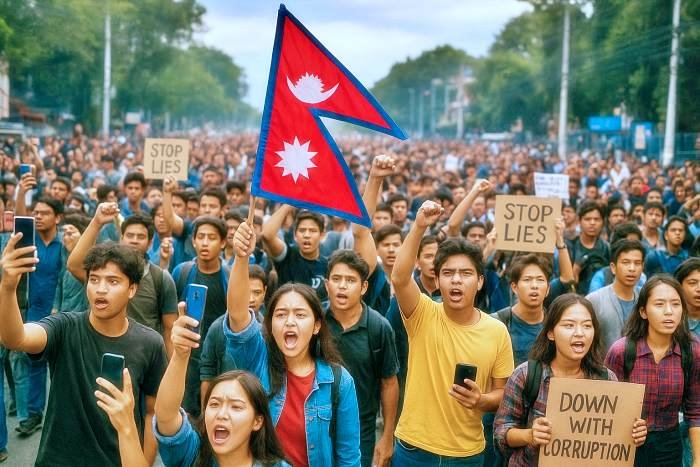In the hands of Gen Z, protest is not chaos—it’s a vision for tomorrow.
In September 2025, Nepal’s streets filled with a new kind of protester: teenagers and twenty-somethings who grew up online and refuse to accept politics as usual. This Generation Z, the first in Nepal raised with smartphones and social media as everyday tools, mobilized at breathtaking speed when the government banned more than two dozen social platforms. What began as anger over losing their digital spaces soon became a mass movement against corruption, inequality, and a political class many young people see as hopelessly out of touch.
The government’s decision to block Facebook, YouTube, Instagram, TikTok, and other platforms was meant to enforce new registration rules. Instead, it backfired. For Nepal’s Gen Z, these weren’t just apps—they were classrooms, job boards, news outlets, and most importantly, their voices. The ban felt like being silenced. “It was as if someone took away our megaphone,” one young protester told The Guardian. Within hours, digital frustration spilled into real-world marches.
What made this uprising unusual was its lack of formal leadership. Unlike earlier protests, no party boss, union head, or activist celebrity stood at the front. Instead, students and young workers responded to each other’s posts, videos, and calls to gather at iconic sites like Maitighar Mandala in Kathmandu. The energy spread peer-to-peer, city to city, without central direction. Reuters described it as a “leaderless uprising,” but leaderless did not mean powerless—the sheer number of young people, and their ability to amplify messages across countless small networks, overwhelmed the government’s ability to contain them.
As demonstrations swelled, police cracked down with tear gas, rubber bullets, and in some instances, live ammunition. At least 19 people lost their lives, and hundreds were injured. Yet instead of scaring the protesters off, the violence hardened their resolve. Images of police confrontations circulated quickly—even though social media was officially banned, workarounds kept the videos flowing. Each clip of a young person standing up to riot shields or carrying an injured friend became a rallying cry.
The movement forced dramatic political fallout. Home Minister Rabi Lamichhane resigned first. Then, under unrelenting pressure, Prime Minister K.P. Sharma Oli stepped down. The government lifted the social media ban and promised compensation for victims’ families. But for Nepal’s Gen Z, these concessions were only a beginning.
Observers say the protests have revealed both the promise and the challenge of Gen Z politics. Their ability to mobilize quickly, channel moral outrage, and sidestep old power structures is extraordinary. But without established leadership or unified demands, sustaining momentum is harder. For now, though, the message is unmistakable: Nepal’s youngest citizens are not waiting for permission to shape their country’s future. They are already doing it—in the streets, on their phones, and in the collective imagination of what a more accountable Nepal could look like.

And history did not stop there. In an extraordinary turn, former Chief Justice Sushila Karki has been selected as Nepal’s Interim Prime Minister. With parliament dissolved, she and her cabinet—chosen independently—hold full powers to guide the country until fresh elections. For the first time, a leader without political baggage stands at the helm, enjoying both moral authority and public trust.
For Nepal, a hill nation often overlooked on the world stage, this is nothing short of a golden opportunity. If a non-politician can restore governance and faith in institutions, it could become a model for others. The youth who filled the streets have shown that democracy is not only about parties and leaders—it can also be about ordinary citizens reshaping their country.
The world is watching, and the hope is simple: that the best sense prevails, and Nepal writes a chapter that inspires far beyond its borders.
Current Affairs Capsule
- What happened? Nepal banned major social media apps, sparking huge youth-led protests.
- What followed? The protests forced the Home Minister and Prime Minister to resign.
- Who is in charge now? Former Chief Justice Sushila Karki has become Nepal’s Interim Prime Minister with full powers.
- Why does it matter? For the first time, a non-politician is leading Nepal, giving the country a rare chance to clean up governance.
- Big picture: The world is watching how Nepal’s youth and new leadership shape the nation’s future.
Did You Know?
Sushila Karki is Nepal’s first woman Chief Justice—and now also its first woman Prime Minister!
Global Wrap: News That Matters
In today’s fast-moving world, it’s easy to miss out on events that are quietly reshaping our future. Prizdale Times brings you a regular wrap-up of the most important happenings across the globe—clear, concise, and meaningful. Whether you are a concerned citizen wanting to stay informed, Teenager or a competitive exam aspirant who needs reliable updates, this feature is designed for you. No noise, no clutter—just the essential stories and insights that matter… Team Laurels